HR Strategies for Attracting and Retaining Staff in Healthcare - CQU
VerifiedAdded on 2023/03/31
|10
|3055
|121
Essay
AI Summary
This essay discusses the critical role of Human Resources in healthcare organizations, focusing on strategies for attracting and retaining employees. It highlights the challenges of high employee turnover and the importance of effective HR planning in a competitive environment. The essay examines performance management, talent attraction and selection, strategic reward systems, and workplace health and safety as key components of a successful HR strategy. It emphasizes the need for healthcare organizations to adopt modern approaches, leverage technology, and offer competitive benefits to attract and retain talented staff, ultimately improving organizational performance and patient care. The essay also underscores the importance of aligning individual employee goals with organizational objectives to foster loyalty and job satisfaction.
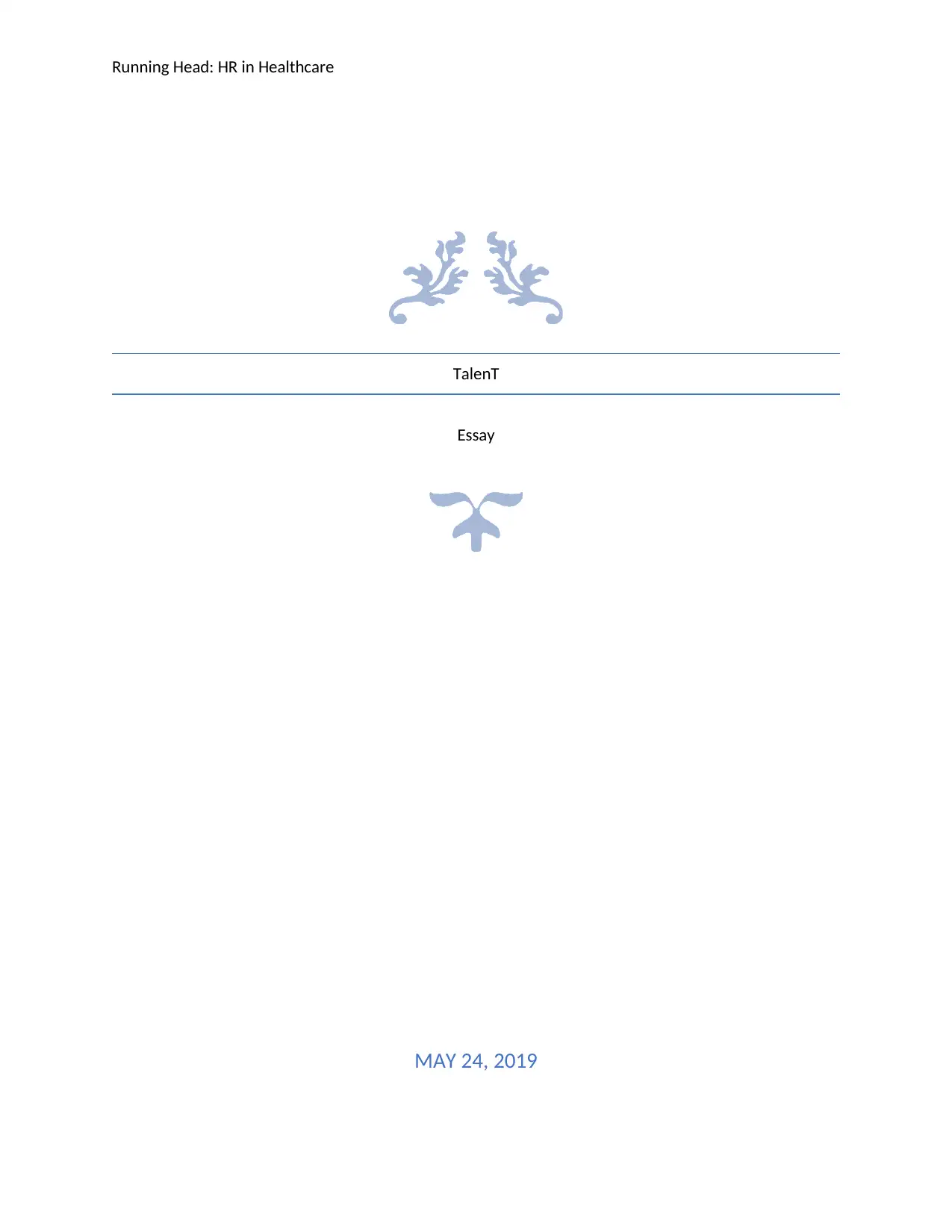
Running Head: HR in Healthcare
TalenT
Essay
MAY 24, 2019
TalenT
Essay
MAY 24, 2019
Secure Best Marks with AI Grader
Need help grading? Try our AI Grader for instant feedback on your assignments.
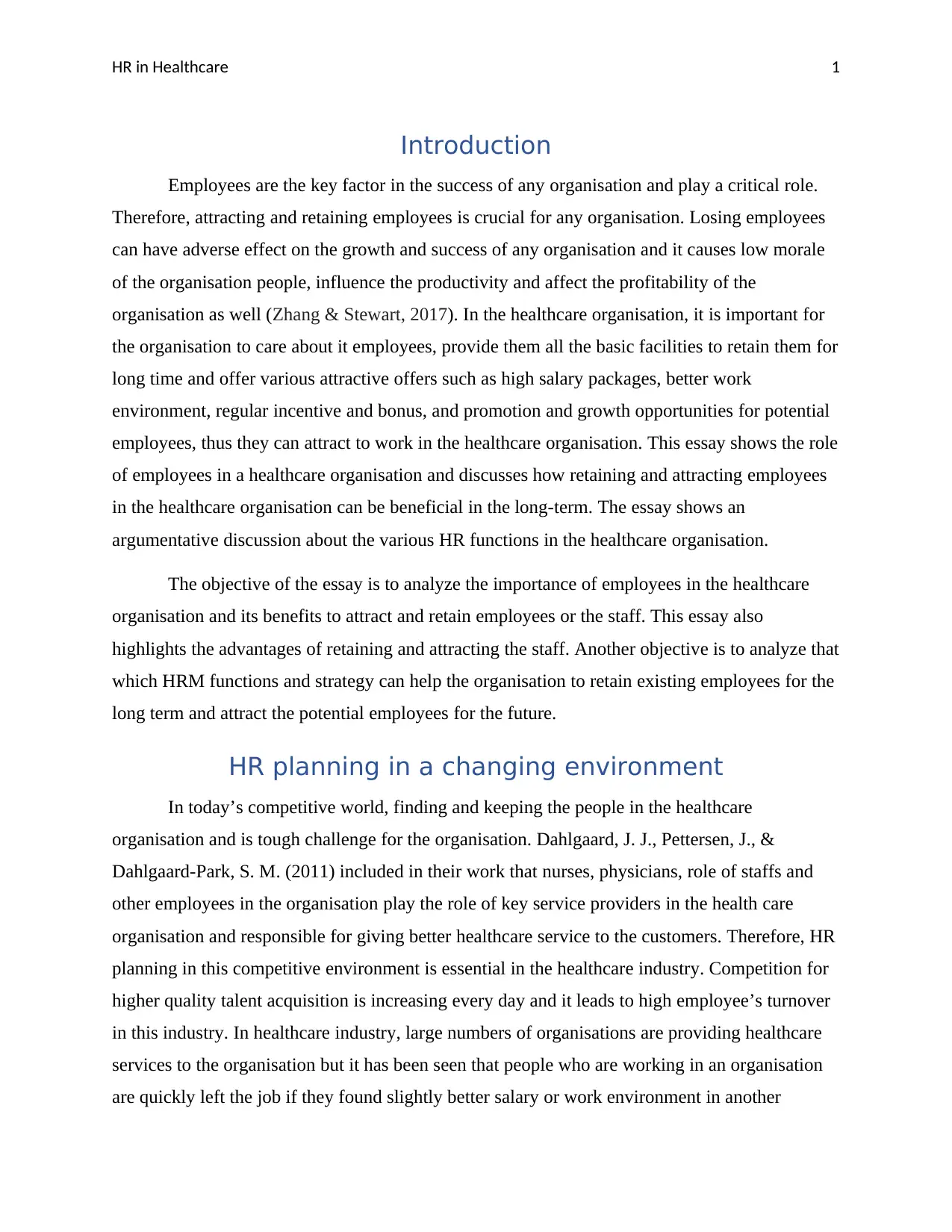
HR in Healthcare 1
Introduction
Employees are the key factor in the success of any organisation and play a critical role.
Therefore, attracting and retaining employees is crucial for any organisation. Losing employees
can have adverse effect on the growth and success of any organisation and it causes low morale
of the organisation people, influence the productivity and affect the profitability of the
organisation as well (Zhang & Stewart, 2017). In the healthcare organisation, it is important for
the organisation to care about it employees, provide them all the basic facilities to retain them for
long time and offer various attractive offers such as high salary packages, better work
environment, regular incentive and bonus, and promotion and growth opportunities for potential
employees, thus they can attract to work in the healthcare organisation. This essay shows the role
of employees in a healthcare organisation and discusses how retaining and attracting employees
in the healthcare organisation can be beneficial in the long-term. The essay shows an
argumentative discussion about the various HR functions in the healthcare organisation.
The objective of the essay is to analyze the importance of employees in the healthcare
organisation and its benefits to attract and retain employees or the staff. This essay also
highlights the advantages of retaining and attracting the staff. Another objective is to analyze that
which HRM functions and strategy can help the organisation to retain existing employees for the
long term and attract the potential employees for the future.
HR planning in a changing environment
In today’s competitive world, finding and keeping the people in the healthcare
organisation and is tough challenge for the organisation. Dahlgaard, J. J., Pettersen, J., &
Dahlgaard-Park, S. M. (2011) included in their work that nurses, physicians, role of staffs and
other employees in the organisation play the role of key service providers in the health care
organisation and responsible for giving better healthcare service to the customers. Therefore, HR
planning in this competitive environment is essential in the healthcare industry. Competition for
higher quality talent acquisition is increasing every day and it leads to high employee’s turnover
in this industry. In healthcare industry, large numbers of organisations are providing healthcare
services to the organisation but it has been seen that people who are working in an organisation
are quickly left the job if they found slightly better salary or work environment in another
Introduction
Employees are the key factor in the success of any organisation and play a critical role.
Therefore, attracting and retaining employees is crucial for any organisation. Losing employees
can have adverse effect on the growth and success of any organisation and it causes low morale
of the organisation people, influence the productivity and affect the profitability of the
organisation as well (Zhang & Stewart, 2017). In the healthcare organisation, it is important for
the organisation to care about it employees, provide them all the basic facilities to retain them for
long time and offer various attractive offers such as high salary packages, better work
environment, regular incentive and bonus, and promotion and growth opportunities for potential
employees, thus they can attract to work in the healthcare organisation. This essay shows the role
of employees in a healthcare organisation and discusses how retaining and attracting employees
in the healthcare organisation can be beneficial in the long-term. The essay shows an
argumentative discussion about the various HR functions in the healthcare organisation.
The objective of the essay is to analyze the importance of employees in the healthcare
organisation and its benefits to attract and retain employees or the staff. This essay also
highlights the advantages of retaining and attracting the staff. Another objective is to analyze that
which HRM functions and strategy can help the organisation to retain existing employees for the
long term and attract the potential employees for the future.
HR planning in a changing environment
In today’s competitive world, finding and keeping the people in the healthcare
organisation and is tough challenge for the organisation. Dahlgaard, J. J., Pettersen, J., &
Dahlgaard-Park, S. M. (2011) included in their work that nurses, physicians, role of staffs and
other employees in the organisation play the role of key service providers in the health care
organisation and responsible for giving better healthcare service to the customers. Therefore, HR
planning in this competitive environment is essential in the healthcare industry. Competition for
higher quality talent acquisition is increasing every day and it leads to high employee’s turnover
in this industry. In healthcare industry, large numbers of organisations are providing healthcare
services to the organisation but it has been seen that people who are working in an organisation
are quickly left the job if they found slightly better salary or work environment in another
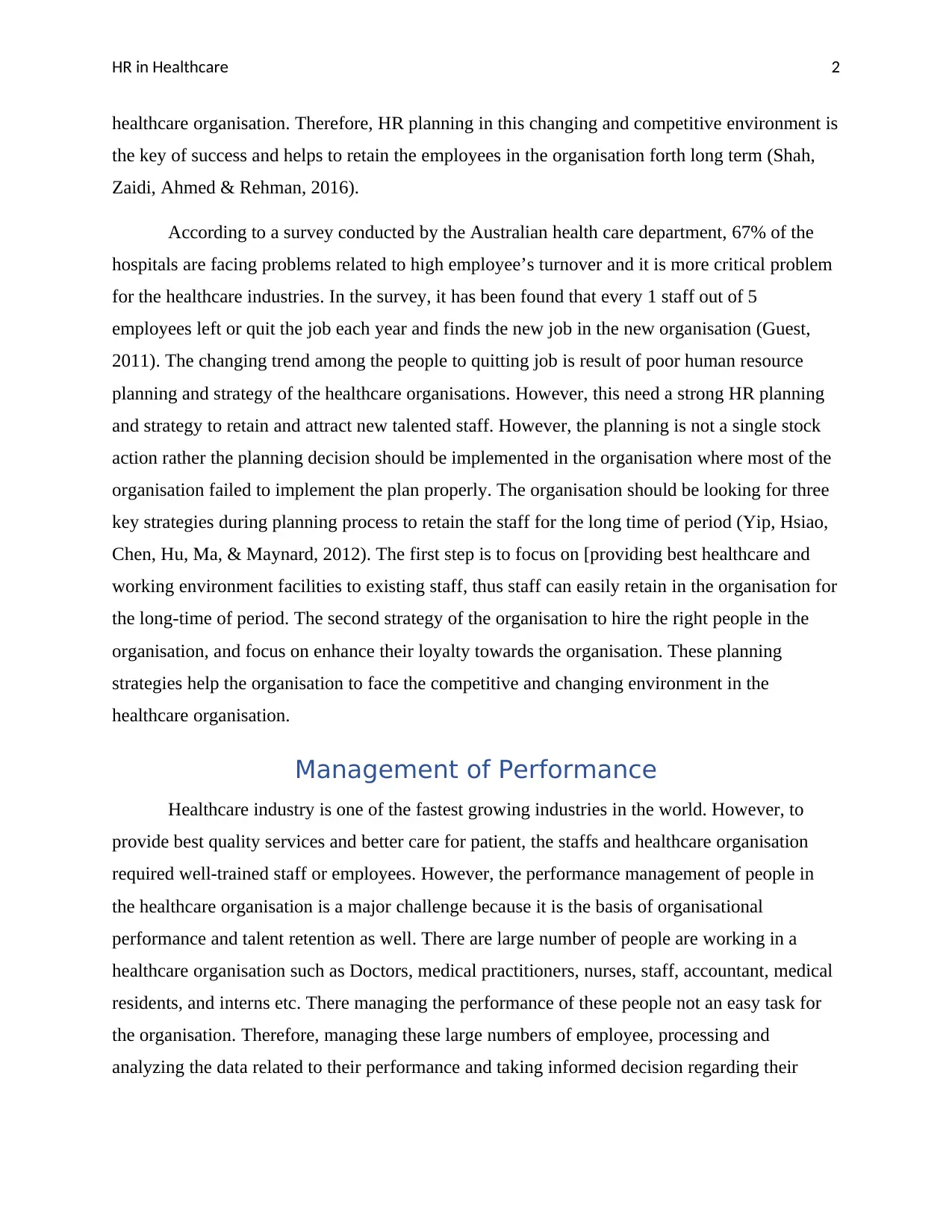
HR in Healthcare 2
healthcare organisation. Therefore, HR planning in this changing and competitive environment is
the key of success and helps to retain the employees in the organisation forth long term (Shah,
Zaidi, Ahmed & Rehman, 2016).
According to a survey conducted by the Australian health care department, 67% of the
hospitals are facing problems related to high employee’s turnover and it is more critical problem
for the healthcare industries. In the survey, it has been found that every 1 staff out of 5
employees left or quit the job each year and finds the new job in the new organisation (Guest,
2011). The changing trend among the people to quitting job is result of poor human resource
planning and strategy of the healthcare organisations. However, this need a strong HR planning
and strategy to retain and attract new talented staff. However, the planning is not a single stock
action rather the planning decision should be implemented in the organisation where most of the
organisation failed to implement the plan properly. The organisation should be looking for three
key strategies during planning process to retain the staff for the long time of period (Yip, Hsiao,
Chen, Hu, Ma, & Maynard, 2012). The first step is to focus on [providing best healthcare and
working environment facilities to existing staff, thus staff can easily retain in the organisation for
the long-time of period. The second strategy of the organisation to hire the right people in the
organisation, and focus on enhance their loyalty towards the organisation. These planning
strategies help the organisation to face the competitive and changing environment in the
healthcare organisation.
Management of Performance
Healthcare industry is one of the fastest growing industries in the world. However, to
provide best quality services and better care for patient, the staffs and healthcare organisation
required well-trained staff or employees. However, the performance management of people in
the healthcare organisation is a major challenge because it is the basis of organisational
performance and talent retention as well. There are large number of people are working in a
healthcare organisation such as Doctors, medical practitioners, nurses, staff, accountant, medical
residents, and interns etc. There managing the performance of these people not an easy task for
the organisation. Therefore, managing these large numbers of employee, processing and
analyzing the data related to their performance and taking informed decision regarding their
healthcare organisation. Therefore, HR planning in this changing and competitive environment is
the key of success and helps to retain the employees in the organisation forth long term (Shah,
Zaidi, Ahmed & Rehman, 2016).
According to a survey conducted by the Australian health care department, 67% of the
hospitals are facing problems related to high employee’s turnover and it is more critical problem
for the healthcare industries. In the survey, it has been found that every 1 staff out of 5
employees left or quit the job each year and finds the new job in the new organisation (Guest,
2011). The changing trend among the people to quitting job is result of poor human resource
planning and strategy of the healthcare organisations. However, this need a strong HR planning
and strategy to retain and attract new talented staff. However, the planning is not a single stock
action rather the planning decision should be implemented in the organisation where most of the
organisation failed to implement the plan properly. The organisation should be looking for three
key strategies during planning process to retain the staff for the long time of period (Yip, Hsiao,
Chen, Hu, Ma, & Maynard, 2012). The first step is to focus on [providing best healthcare and
working environment facilities to existing staff, thus staff can easily retain in the organisation for
the long-time of period. The second strategy of the organisation to hire the right people in the
organisation, and focus on enhance their loyalty towards the organisation. These planning
strategies help the organisation to face the competitive and changing environment in the
healthcare organisation.
Management of Performance
Healthcare industry is one of the fastest growing industries in the world. However, to
provide best quality services and better care for patient, the staffs and healthcare organisation
required well-trained staff or employees. However, the performance management of people in
the healthcare organisation is a major challenge because it is the basis of organisational
performance and talent retention as well. There are large number of people are working in a
healthcare organisation such as Doctors, medical practitioners, nurses, staff, accountant, medical
residents, and interns etc. There managing the performance of these people not an easy task for
the organisation. Therefore, managing these large numbers of employee, processing and
analyzing the data related to their performance and taking informed decision regarding their
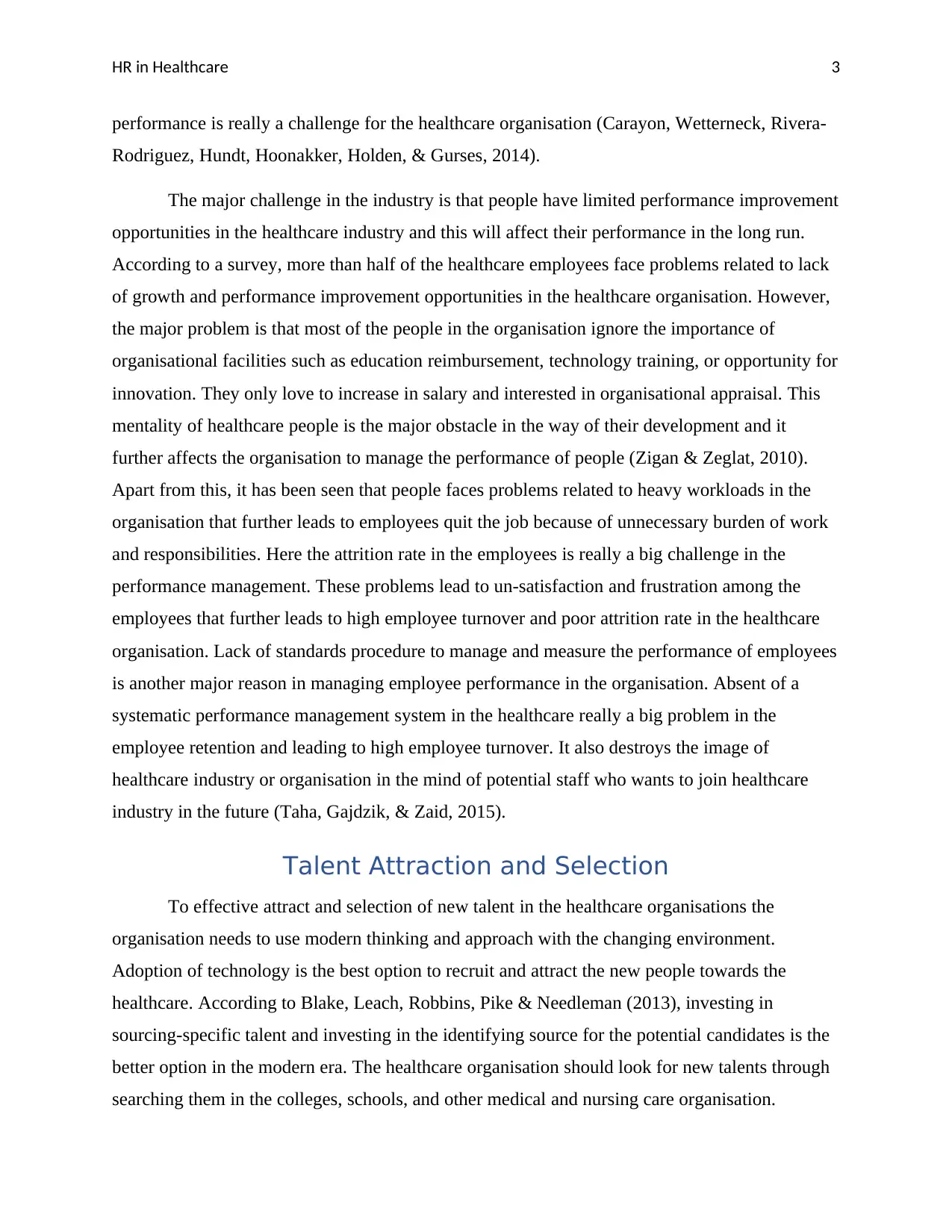
HR in Healthcare 3
performance is really a challenge for the healthcare organisation (Carayon, Wetterneck, Rivera-
Rodriguez, Hundt, Hoonakker, Holden, & Gurses, 2014).
The major challenge in the industry is that people have limited performance improvement
opportunities in the healthcare industry and this will affect their performance in the long run.
According to a survey, more than half of the healthcare employees face problems related to lack
of growth and performance improvement opportunities in the healthcare organisation. However,
the major problem is that most of the people in the organisation ignore the importance of
organisational facilities such as education reimbursement, technology training, or opportunity for
innovation. They only love to increase in salary and interested in organisational appraisal. This
mentality of healthcare people is the major obstacle in the way of their development and it
further affects the organisation to manage the performance of people (Zigan & Zeglat, 2010).
Apart from this, it has been seen that people faces problems related to heavy workloads in the
organisation that further leads to employees quit the job because of unnecessary burden of work
and responsibilities. Here the attrition rate in the employees is really a big challenge in the
performance management. These problems lead to un-satisfaction and frustration among the
employees that further leads to high employee turnover and poor attrition rate in the healthcare
organisation. Lack of standards procedure to manage and measure the performance of employees
is another major reason in managing employee performance in the organisation. Absent of a
systematic performance management system in the healthcare really a big problem in the
employee retention and leading to high employee turnover. It also destroys the image of
healthcare industry or organisation in the mind of potential staff who wants to join healthcare
industry in the future (Taha, Gajdzik, & Zaid, 2015).
Talent Attraction and Selection
To effective attract and selection of new talent in the healthcare organisations the
organisation needs to use modern thinking and approach with the changing environment.
Adoption of technology is the best option to recruit and attract the new people towards the
healthcare. According to Blake, Leach, Robbins, Pike & Needleman (2013), investing in
sourcing-specific talent and investing in the identifying source for the potential candidates is the
better option in the modern era. The healthcare organisation should look for new talents through
searching them in the colleges, schools, and other medical and nursing care organisation.
performance is really a challenge for the healthcare organisation (Carayon, Wetterneck, Rivera-
Rodriguez, Hundt, Hoonakker, Holden, & Gurses, 2014).
The major challenge in the industry is that people have limited performance improvement
opportunities in the healthcare industry and this will affect their performance in the long run.
According to a survey, more than half of the healthcare employees face problems related to lack
of growth and performance improvement opportunities in the healthcare organisation. However,
the major problem is that most of the people in the organisation ignore the importance of
organisational facilities such as education reimbursement, technology training, or opportunity for
innovation. They only love to increase in salary and interested in organisational appraisal. This
mentality of healthcare people is the major obstacle in the way of their development and it
further affects the organisation to manage the performance of people (Zigan & Zeglat, 2010).
Apart from this, it has been seen that people faces problems related to heavy workloads in the
organisation that further leads to employees quit the job because of unnecessary burden of work
and responsibilities. Here the attrition rate in the employees is really a big challenge in the
performance management. These problems lead to un-satisfaction and frustration among the
employees that further leads to high employee turnover and poor attrition rate in the healthcare
organisation. Lack of standards procedure to manage and measure the performance of employees
is another major reason in managing employee performance in the organisation. Absent of a
systematic performance management system in the healthcare really a big problem in the
employee retention and leading to high employee turnover. It also destroys the image of
healthcare industry or organisation in the mind of potential staff who wants to join healthcare
industry in the future (Taha, Gajdzik, & Zaid, 2015).
Talent Attraction and Selection
To effective attract and selection of new talent in the healthcare organisations the
organisation needs to use modern thinking and approach with the changing environment.
Adoption of technology is the best option to recruit and attract the new people towards the
healthcare. According to Blake, Leach, Robbins, Pike & Needleman (2013), investing in
sourcing-specific talent and investing in the identifying source for the potential candidates is the
better option in the modern era. The healthcare organisation should look for new talents through
searching them in the colleges, schools, and other medical and nursing care organisation.
Secure Best Marks with AI Grader
Need help grading? Try our AI Grader for instant feedback on your assignments.
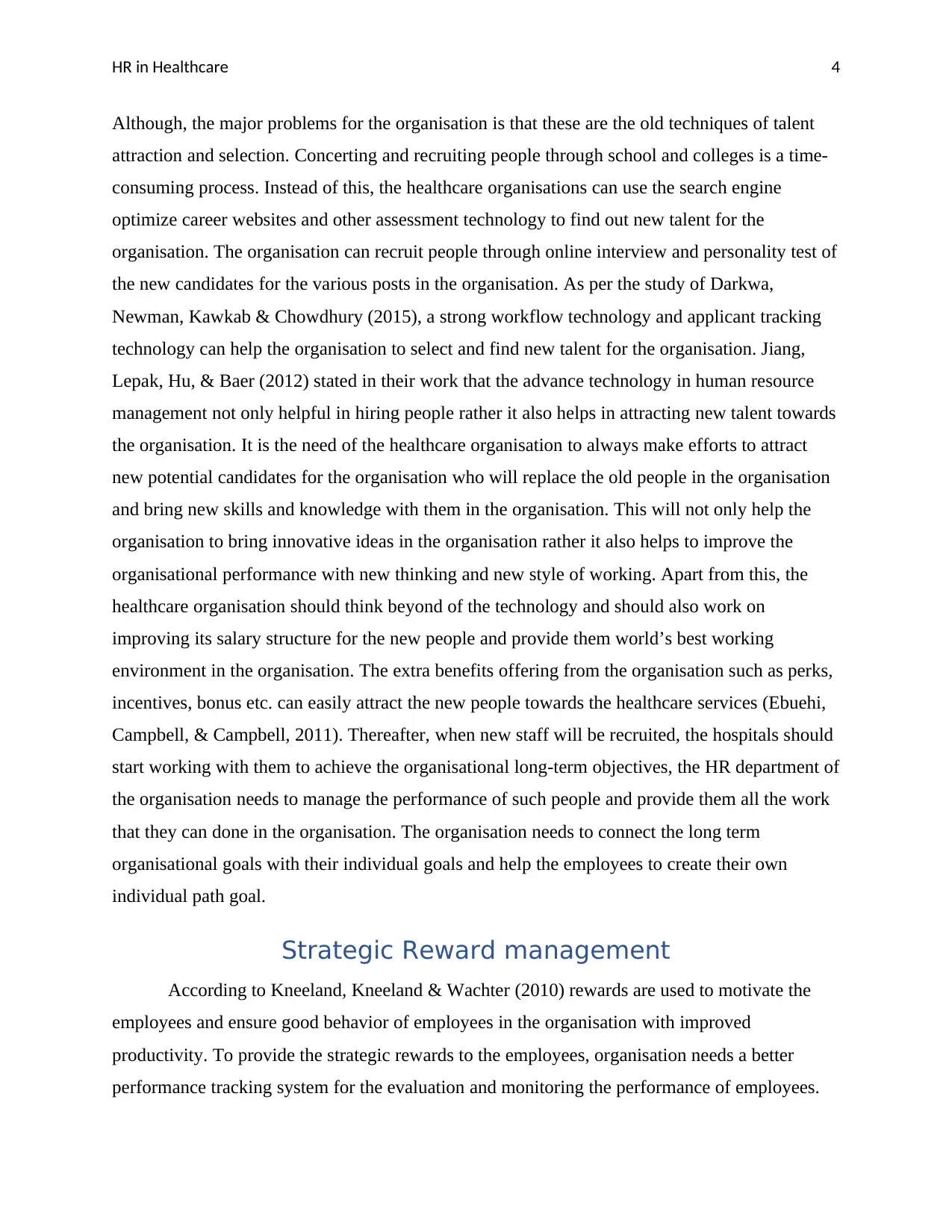
HR in Healthcare 4
Although, the major problems for the organisation is that these are the old techniques of talent
attraction and selection. Concerting and recruiting people through school and colleges is a time-
consuming process. Instead of this, the healthcare organisations can use the search engine
optimize career websites and other assessment technology to find out new talent for the
organisation. The organisation can recruit people through online interview and personality test of
the new candidates for the various posts in the organisation. As per the study of Darkwa,
Newman, Kawkab & Chowdhury (2015), a strong workflow technology and applicant tracking
technology can help the organisation to select and find new talent for the organisation. Jiang,
Lepak, Hu, & Baer (2012) stated in their work that the advance technology in human resource
management not only helpful in hiring people rather it also helps in attracting new talent towards
the organisation. It is the need of the healthcare organisation to always make efforts to attract
new potential candidates for the organisation who will replace the old people in the organisation
and bring new skills and knowledge with them in the organisation. This will not only help the
organisation to bring innovative ideas in the organisation rather it also helps to improve the
organisational performance with new thinking and new style of working. Apart from this, the
healthcare organisation should think beyond of the technology and should also work on
improving its salary structure for the new people and provide them world’s best working
environment in the organisation. The extra benefits offering from the organisation such as perks,
incentives, bonus etc. can easily attract the new people towards the healthcare services (Ebuehi,
Campbell, & Campbell, 2011). Thereafter, when new staff will be recruited, the hospitals should
start working with them to achieve the organisational long-term objectives, the HR department of
the organisation needs to manage the performance of such people and provide them all the work
that they can done in the organisation. The organisation needs to connect the long term
organisational goals with their individual goals and help the employees to create their own
individual path goal.
Strategic Reward management
According to Kneeland, Kneeland & Wachter (2010) rewards are used to motivate the
employees and ensure good behavior of employees in the organisation with improved
productivity. To provide the strategic rewards to the employees, organisation needs a better
performance tracking system for the evaluation and monitoring the performance of employees.
Although, the major problems for the organisation is that these are the old techniques of talent
attraction and selection. Concerting and recruiting people through school and colleges is a time-
consuming process. Instead of this, the healthcare organisations can use the search engine
optimize career websites and other assessment technology to find out new talent for the
organisation. The organisation can recruit people through online interview and personality test of
the new candidates for the various posts in the organisation. As per the study of Darkwa,
Newman, Kawkab & Chowdhury (2015), a strong workflow technology and applicant tracking
technology can help the organisation to select and find new talent for the organisation. Jiang,
Lepak, Hu, & Baer (2012) stated in their work that the advance technology in human resource
management not only helpful in hiring people rather it also helps in attracting new talent towards
the organisation. It is the need of the healthcare organisation to always make efforts to attract
new potential candidates for the organisation who will replace the old people in the organisation
and bring new skills and knowledge with them in the organisation. This will not only help the
organisation to bring innovative ideas in the organisation rather it also helps to improve the
organisational performance with new thinking and new style of working. Apart from this, the
healthcare organisation should think beyond of the technology and should also work on
improving its salary structure for the new people and provide them world’s best working
environment in the organisation. The extra benefits offering from the organisation such as perks,
incentives, bonus etc. can easily attract the new people towards the healthcare services (Ebuehi,
Campbell, & Campbell, 2011). Thereafter, when new staff will be recruited, the hospitals should
start working with them to achieve the organisational long-term objectives, the HR department of
the organisation needs to manage the performance of such people and provide them all the work
that they can done in the organisation. The organisation needs to connect the long term
organisational goals with their individual goals and help the employees to create their own
individual path goal.
Strategic Reward management
According to Kneeland, Kneeland & Wachter (2010) rewards are used to motivate the
employees and ensure good behavior of employees in the organisation with improved
productivity. To provide the strategic rewards to the employees, organisation needs a better
performance tracking system for the evaluation and monitoring the performance of employees.
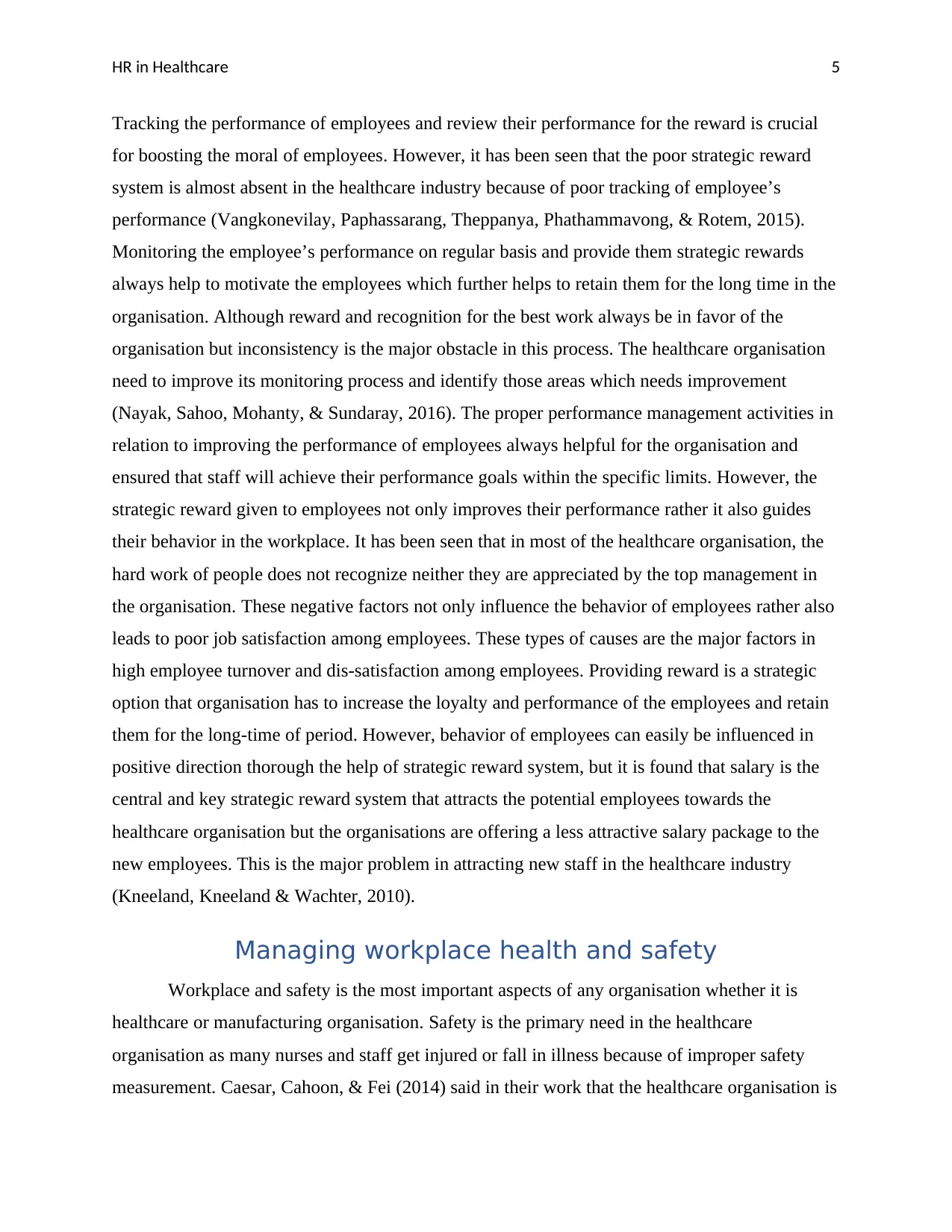
HR in Healthcare 5
Tracking the performance of employees and review their performance for the reward is crucial
for boosting the moral of employees. However, it has been seen that the poor strategic reward
system is almost absent in the healthcare industry because of poor tracking of employee’s
performance (Vangkonevilay, Paphassarang, Theppanya, Phathammavong, & Rotem, 2015).
Monitoring the employee’s performance on regular basis and provide them strategic rewards
always help to motivate the employees which further helps to retain them for the long time in the
organisation. Although reward and recognition for the best work always be in favor of the
organisation but inconsistency is the major obstacle in this process. The healthcare organisation
need to improve its monitoring process and identify those areas which needs improvement
(Nayak, Sahoo, Mohanty, & Sundaray, 2016). The proper performance management activities in
relation to improving the performance of employees always helpful for the organisation and
ensured that staff will achieve their performance goals within the specific limits. However, the
strategic reward given to employees not only improves their performance rather it also guides
their behavior in the workplace. It has been seen that in most of the healthcare organisation, the
hard work of people does not recognize neither they are appreciated by the top management in
the organisation. These negative factors not only influence the behavior of employees rather also
leads to poor job satisfaction among employees. These types of causes are the major factors in
high employee turnover and dis-satisfaction among employees. Providing reward is a strategic
option that organisation has to increase the loyalty and performance of the employees and retain
them for the long-time of period. However, behavior of employees can easily be influenced in
positive direction thorough the help of strategic reward system, but it is found that salary is the
central and key strategic reward system that attracts the potential employees towards the
healthcare organisation but the organisations are offering a less attractive salary package to the
new employees. This is the major problem in attracting new staff in the healthcare industry
(Kneeland, Kneeland & Wachter, 2010).
Managing workplace health and safety
Workplace and safety is the most important aspects of any organisation whether it is
healthcare or manufacturing organisation. Safety is the primary need in the healthcare
organisation as many nurses and staff get injured or fall in illness because of improper safety
measurement. Caesar, Cahoon, & Fei (2014) said in their work that the healthcare organisation is
Tracking the performance of employees and review their performance for the reward is crucial
for boosting the moral of employees. However, it has been seen that the poor strategic reward
system is almost absent in the healthcare industry because of poor tracking of employee’s
performance (Vangkonevilay, Paphassarang, Theppanya, Phathammavong, & Rotem, 2015).
Monitoring the employee’s performance on regular basis and provide them strategic rewards
always help to motivate the employees which further helps to retain them for the long time in the
organisation. Although reward and recognition for the best work always be in favor of the
organisation but inconsistency is the major obstacle in this process. The healthcare organisation
need to improve its monitoring process and identify those areas which needs improvement
(Nayak, Sahoo, Mohanty, & Sundaray, 2016). The proper performance management activities in
relation to improving the performance of employees always helpful for the organisation and
ensured that staff will achieve their performance goals within the specific limits. However, the
strategic reward given to employees not only improves their performance rather it also guides
their behavior in the workplace. It has been seen that in most of the healthcare organisation, the
hard work of people does not recognize neither they are appreciated by the top management in
the organisation. These negative factors not only influence the behavior of employees rather also
leads to poor job satisfaction among employees. These types of causes are the major factors in
high employee turnover and dis-satisfaction among employees. Providing reward is a strategic
option that organisation has to increase the loyalty and performance of the employees and retain
them for the long-time of period. However, behavior of employees can easily be influenced in
positive direction thorough the help of strategic reward system, but it is found that salary is the
central and key strategic reward system that attracts the potential employees towards the
healthcare organisation but the organisations are offering a less attractive salary package to the
new employees. This is the major problem in attracting new staff in the healthcare industry
(Kneeland, Kneeland & Wachter, 2010).
Managing workplace health and safety
Workplace and safety is the most important aspects of any organisation whether it is
healthcare or manufacturing organisation. Safety is the primary need in the healthcare
organisation as many nurses and staff get injured or fall in illness because of improper safety
measurement. Caesar, Cahoon, & Fei (2014) said in their work that the healthcare organisation is
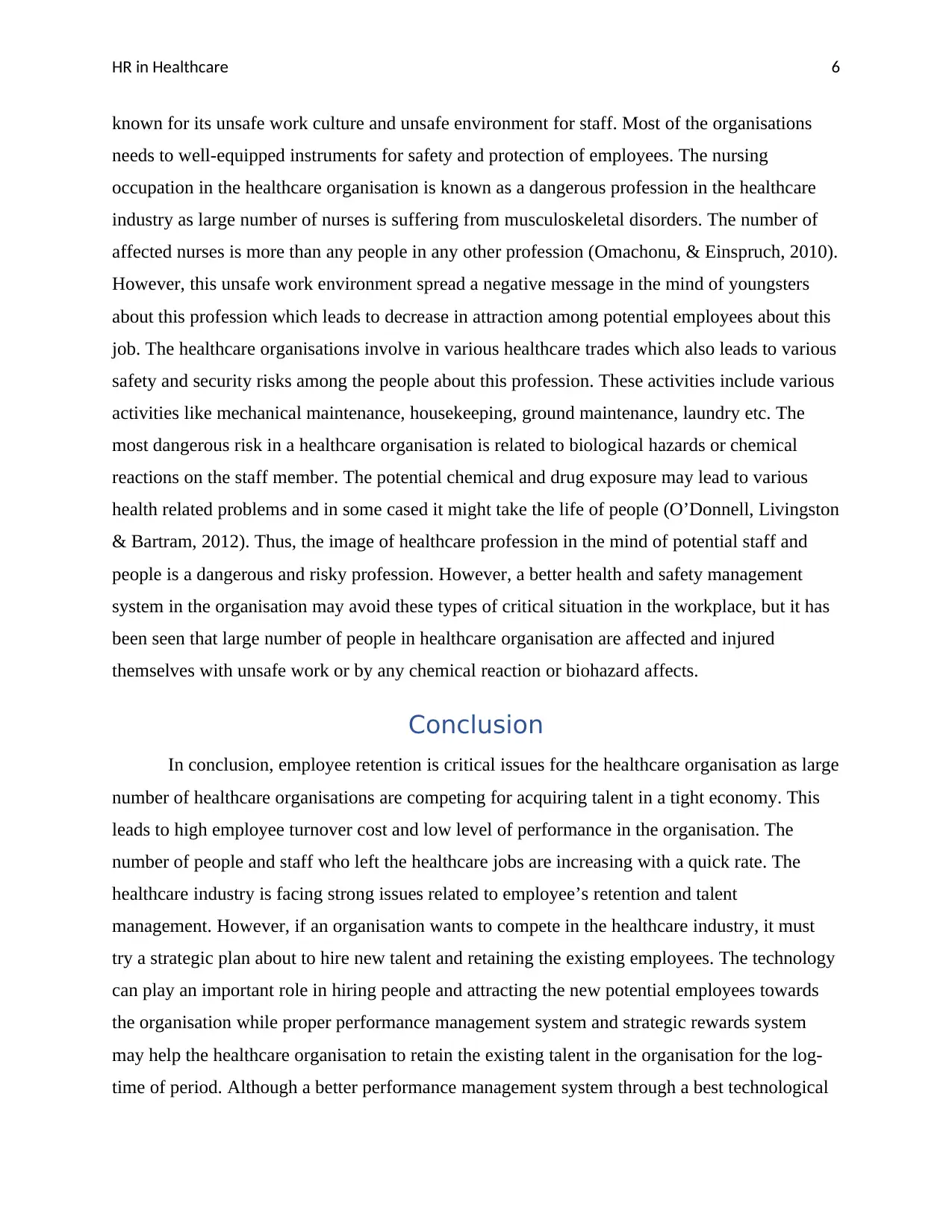
HR in Healthcare 6
known for its unsafe work culture and unsafe environment for staff. Most of the organisations
needs to well-equipped instruments for safety and protection of employees. The nursing
occupation in the healthcare organisation is known as a dangerous profession in the healthcare
industry as large number of nurses is suffering from musculoskeletal disorders. The number of
affected nurses is more than any people in any other profession (Omachonu, & Einspruch, 2010).
However, this unsafe work environment spread a negative message in the mind of youngsters
about this profession which leads to decrease in attraction among potential employees about this
job. The healthcare organisations involve in various healthcare trades which also leads to various
safety and security risks among the people about this profession. These activities include various
activities like mechanical maintenance, housekeeping, ground maintenance, laundry etc. The
most dangerous risk in a healthcare organisation is related to biological hazards or chemical
reactions on the staff member. The potential chemical and drug exposure may lead to various
health related problems and in some cased it might take the life of people (O’Donnell, Livingston
& Bartram, 2012). Thus, the image of healthcare profession in the mind of potential staff and
people is a dangerous and risky profession. However, a better health and safety management
system in the organisation may avoid these types of critical situation in the workplace, but it has
been seen that large number of people in healthcare organisation are affected and injured
themselves with unsafe work or by any chemical reaction or biohazard affects.
Conclusion
In conclusion, employee retention is critical issues for the healthcare organisation as large
number of healthcare organisations are competing for acquiring talent in a tight economy. This
leads to high employee turnover cost and low level of performance in the organisation. The
number of people and staff who left the healthcare jobs are increasing with a quick rate. The
healthcare industry is facing strong issues related to employee’s retention and talent
management. However, if an organisation wants to compete in the healthcare industry, it must
try a strategic plan about to hire new talent and retaining the existing employees. The technology
can play an important role in hiring people and attracting the new potential employees towards
the organisation while proper performance management system and strategic rewards system
may help the healthcare organisation to retain the existing talent in the organisation for the log-
time of period. Although a better performance management system through a best technological
known for its unsafe work culture and unsafe environment for staff. Most of the organisations
needs to well-equipped instruments for safety and protection of employees. The nursing
occupation in the healthcare organisation is known as a dangerous profession in the healthcare
industry as large number of nurses is suffering from musculoskeletal disorders. The number of
affected nurses is more than any people in any other profession (Omachonu, & Einspruch, 2010).
However, this unsafe work environment spread a negative message in the mind of youngsters
about this profession which leads to decrease in attraction among potential employees about this
job. The healthcare organisations involve in various healthcare trades which also leads to various
safety and security risks among the people about this profession. These activities include various
activities like mechanical maintenance, housekeeping, ground maintenance, laundry etc. The
most dangerous risk in a healthcare organisation is related to biological hazards or chemical
reactions on the staff member. The potential chemical and drug exposure may lead to various
health related problems and in some cased it might take the life of people (O’Donnell, Livingston
& Bartram, 2012). Thus, the image of healthcare profession in the mind of potential staff and
people is a dangerous and risky profession. However, a better health and safety management
system in the organisation may avoid these types of critical situation in the workplace, but it has
been seen that large number of people in healthcare organisation are affected and injured
themselves with unsafe work or by any chemical reaction or biohazard affects.
Conclusion
In conclusion, employee retention is critical issues for the healthcare organisation as large
number of healthcare organisations are competing for acquiring talent in a tight economy. This
leads to high employee turnover cost and low level of performance in the organisation. The
number of people and staff who left the healthcare jobs are increasing with a quick rate. The
healthcare industry is facing strong issues related to employee’s retention and talent
management. However, if an organisation wants to compete in the healthcare industry, it must
try a strategic plan about to hire new talent and retaining the existing employees. The technology
can play an important role in hiring people and attracting the new potential employees towards
the organisation while proper performance management system and strategic rewards system
may help the healthcare organisation to retain the existing talent in the organisation for the log-
time of period. Although a better performance management system through a best technological
Paraphrase This Document
Need a fresh take? Get an instant paraphrase of this document with our AI Paraphraser
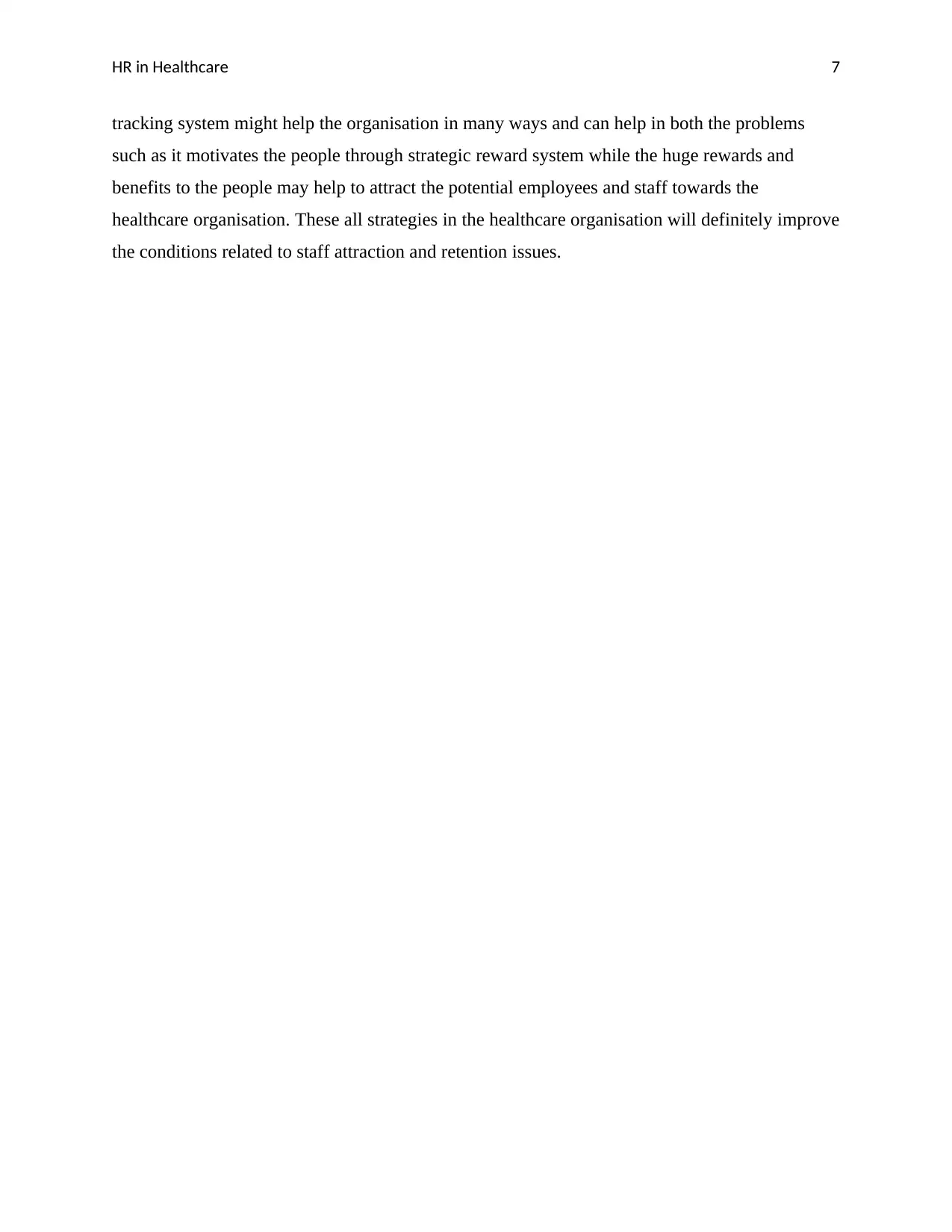
HR in Healthcare 7
tracking system might help the organisation in many ways and can help in both the problems
such as it motivates the people through strategic reward system while the huge rewards and
benefits to the people may help to attract the potential employees and staff towards the
healthcare organisation. These all strategies in the healthcare organisation will definitely improve
the conditions related to staff attraction and retention issues.
tracking system might help the organisation in many ways and can help in both the problems
such as it motivates the people through strategic reward system while the huge rewards and
benefits to the people may help to attract the potential employees and staff towards the
healthcare organisation. These all strategies in the healthcare organisation will definitely improve
the conditions related to staff attraction and retention issues.
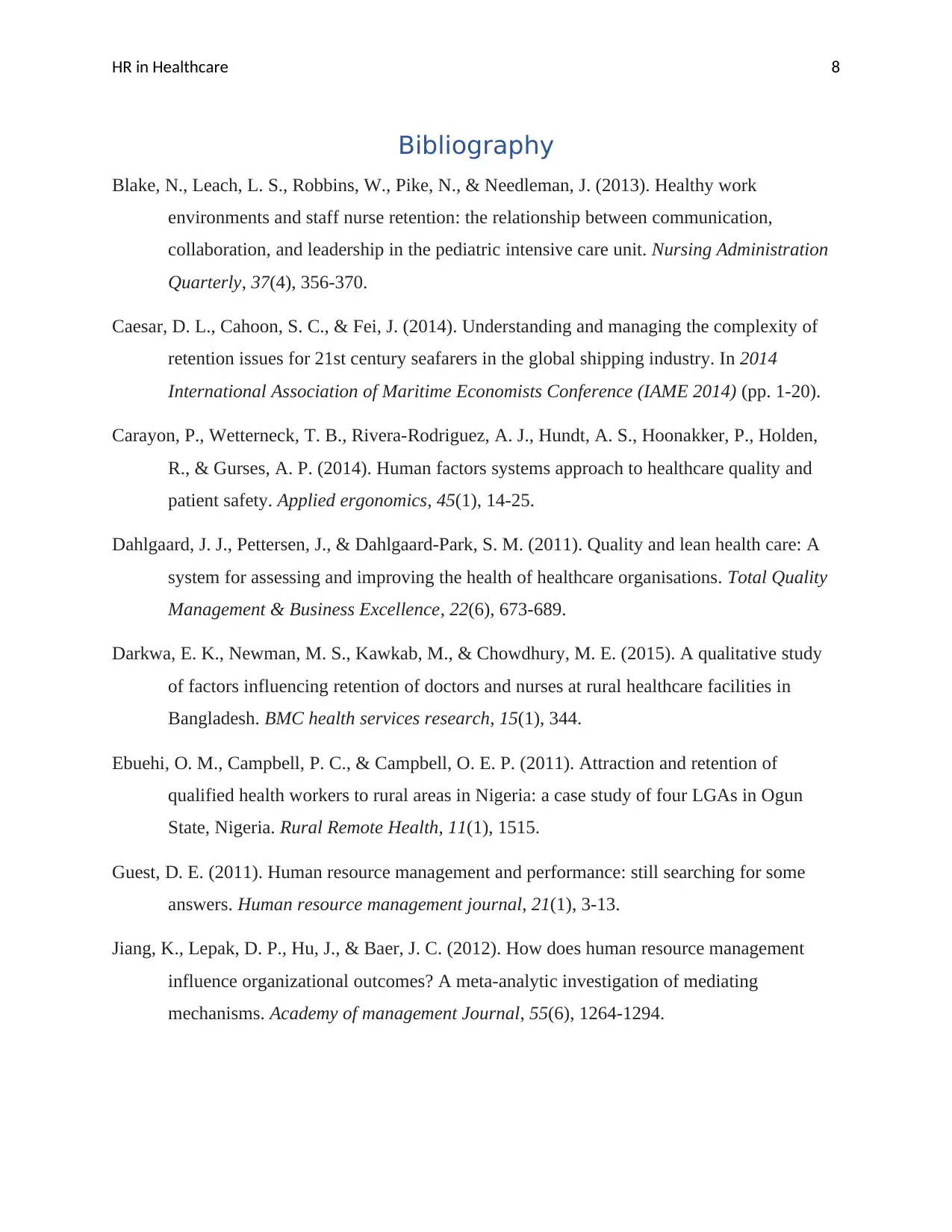
HR in Healthcare 8
Bibliography
Blake, N., Leach, L. S., Robbins, W., Pike, N., & Needleman, J. (2013). Healthy work
environments and staff nurse retention: the relationship between communication,
collaboration, and leadership in the pediatric intensive care unit. Nursing Administration
Quarterly, 37(4), 356-370.
Caesar, D. L., Cahoon, S. C., & Fei, J. (2014). Understanding and managing the complexity of
retention issues for 21st century seafarers in the global shipping industry. In 2014
International Association of Maritime Economists Conference (IAME 2014) (pp. 1-20).
Carayon, P., Wetterneck, T. B., Rivera-Rodriguez, A. J., Hundt, A. S., Hoonakker, P., Holden,
R., & Gurses, A. P. (2014). Human factors systems approach to healthcare quality and
patient safety. Applied ergonomics, 45(1), 14-25.
Dahlgaard, J. J., Pettersen, J., & Dahlgaard-Park, S. M. (2011). Quality and lean health care: A
system for assessing and improving the health of healthcare organisations. Total Quality
Management & Business Excellence, 22(6), 673-689.
Darkwa, E. K., Newman, M. S., Kawkab, M., & Chowdhury, M. E. (2015). A qualitative study
of factors influencing retention of doctors and nurses at rural healthcare facilities in
Bangladesh. BMC health services research, 15(1), 344.
Ebuehi, O. M., Campbell, P. C., & Campbell, O. E. P. (2011). Attraction and retention of
qualified health workers to rural areas in Nigeria: a case study of four LGAs in Ogun
State, Nigeria. Rural Remote Health, 11(1), 1515.
Guest, D. E. (2011). Human resource management and performance: still searching for some
answers. Human resource management journal, 21(1), 3-13.
Jiang, K., Lepak, D. P., Hu, J., & Baer, J. C. (2012). How does human resource management
influence organizational outcomes? A meta-analytic investigation of mediating
mechanisms. Academy of management Journal, 55(6), 1264-1294.
Bibliography
Blake, N., Leach, L. S., Robbins, W., Pike, N., & Needleman, J. (2013). Healthy work
environments and staff nurse retention: the relationship between communication,
collaboration, and leadership in the pediatric intensive care unit. Nursing Administration
Quarterly, 37(4), 356-370.
Caesar, D. L., Cahoon, S. C., & Fei, J. (2014). Understanding and managing the complexity of
retention issues for 21st century seafarers in the global shipping industry. In 2014
International Association of Maritime Economists Conference (IAME 2014) (pp. 1-20).
Carayon, P., Wetterneck, T. B., Rivera-Rodriguez, A. J., Hundt, A. S., Hoonakker, P., Holden,
R., & Gurses, A. P. (2014). Human factors systems approach to healthcare quality and
patient safety. Applied ergonomics, 45(1), 14-25.
Dahlgaard, J. J., Pettersen, J., & Dahlgaard-Park, S. M. (2011). Quality and lean health care: A
system for assessing and improving the health of healthcare organisations. Total Quality
Management & Business Excellence, 22(6), 673-689.
Darkwa, E. K., Newman, M. S., Kawkab, M., & Chowdhury, M. E. (2015). A qualitative study
of factors influencing retention of doctors and nurses at rural healthcare facilities in
Bangladesh. BMC health services research, 15(1), 344.
Ebuehi, O. M., Campbell, P. C., & Campbell, O. E. P. (2011). Attraction and retention of
qualified health workers to rural areas in Nigeria: a case study of four LGAs in Ogun
State, Nigeria. Rural Remote Health, 11(1), 1515.
Guest, D. E. (2011). Human resource management and performance: still searching for some
answers. Human resource management journal, 21(1), 3-13.
Jiang, K., Lepak, D. P., Hu, J., & Baer, J. C. (2012). How does human resource management
influence organizational outcomes? A meta-analytic investigation of mediating
mechanisms. Academy of management Journal, 55(6), 1264-1294.
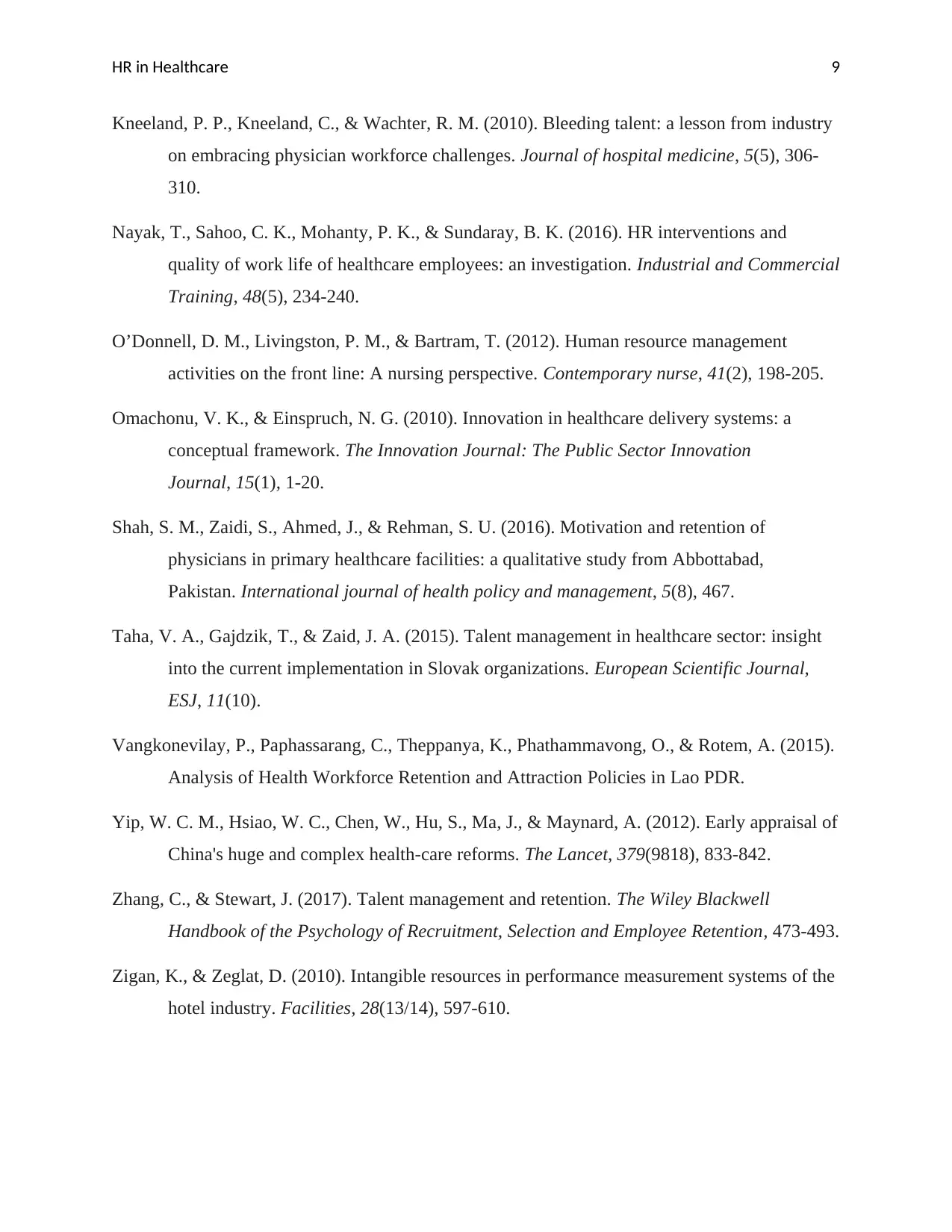
HR in Healthcare 9
Kneeland, P. P., Kneeland, C., & Wachter, R. M. (2010). Bleeding talent: a lesson from industry
on embracing physician workforce challenges. Journal of hospital medicine, 5(5), 306-
310.
Nayak, T., Sahoo, C. K., Mohanty, P. K., & Sundaray, B. K. (2016). HR interventions and
quality of work life of healthcare employees: an investigation. Industrial and Commercial
Training, 48(5), 234-240.
O’Donnell, D. M., Livingston, P. M., & Bartram, T. (2012). Human resource management
activities on the front line: A nursing perspective. Contemporary nurse, 41(2), 198-205.
Omachonu, V. K., & Einspruch, N. G. (2010). Innovation in healthcare delivery systems: a
conceptual framework. The Innovation Journal: The Public Sector Innovation
Journal, 15(1), 1-20.
Shah, S. M., Zaidi, S., Ahmed, J., & Rehman, S. U. (2016). Motivation and retention of
physicians in primary healthcare facilities: a qualitative study from Abbottabad,
Pakistan. International journal of health policy and management, 5(8), 467.
Taha, V. A., Gajdzik, T., & Zaid, J. A. (2015). Talent management in healthcare sector: insight
into the current implementation in Slovak organizations. European Scientific Journal,
ESJ, 11(10).
Vangkonevilay, P., Paphassarang, C., Theppanya, K., Phathammavong, O., & Rotem, A. (2015).
Analysis of Health Workforce Retention and Attraction Policies in Lao PDR.
Yip, W. C. M., Hsiao, W. C., Chen, W., Hu, S., Ma, J., & Maynard, A. (2012). Early appraisal of
China's huge and complex health-care reforms. The Lancet, 379(9818), 833-842.
Zhang, C., & Stewart, J. (2017). Talent management and retention. The Wiley Blackwell
Handbook of the Psychology of Recruitment, Selection and Employee Retention, 473-493.
Zigan, K., & Zeglat, D. (2010). Intangible resources in performance measurement systems of the
hotel industry. Facilities, 28(13/14), 597-610.
Kneeland, P. P., Kneeland, C., & Wachter, R. M. (2010). Bleeding talent: a lesson from industry
on embracing physician workforce challenges. Journal of hospital medicine, 5(5), 306-
310.
Nayak, T., Sahoo, C. K., Mohanty, P. K., & Sundaray, B. K. (2016). HR interventions and
quality of work life of healthcare employees: an investigation. Industrial and Commercial
Training, 48(5), 234-240.
O’Donnell, D. M., Livingston, P. M., & Bartram, T. (2012). Human resource management
activities on the front line: A nursing perspective. Contemporary nurse, 41(2), 198-205.
Omachonu, V. K., & Einspruch, N. G. (2010). Innovation in healthcare delivery systems: a
conceptual framework. The Innovation Journal: The Public Sector Innovation
Journal, 15(1), 1-20.
Shah, S. M., Zaidi, S., Ahmed, J., & Rehman, S. U. (2016). Motivation and retention of
physicians in primary healthcare facilities: a qualitative study from Abbottabad,
Pakistan. International journal of health policy and management, 5(8), 467.
Taha, V. A., Gajdzik, T., & Zaid, J. A. (2015). Talent management in healthcare sector: insight
into the current implementation in Slovak organizations. European Scientific Journal,
ESJ, 11(10).
Vangkonevilay, P., Paphassarang, C., Theppanya, K., Phathammavong, O., & Rotem, A. (2015).
Analysis of Health Workforce Retention and Attraction Policies in Lao PDR.
Yip, W. C. M., Hsiao, W. C., Chen, W., Hu, S., Ma, J., & Maynard, A. (2012). Early appraisal of
China's huge and complex health-care reforms. The Lancet, 379(9818), 833-842.
Zhang, C., & Stewart, J. (2017). Talent management and retention. The Wiley Blackwell
Handbook of the Psychology of Recruitment, Selection and Employee Retention, 473-493.
Zigan, K., & Zeglat, D. (2010). Intangible resources in performance measurement systems of the
hotel industry. Facilities, 28(13/14), 597-610.
1 out of 10
Related Documents
Your All-in-One AI-Powered Toolkit for Academic Success.
+13062052269
info@desklib.com
Available 24*7 on WhatsApp / Email
![[object Object]](/_next/static/media/star-bottom.7253800d.svg)
Unlock your academic potential
© 2024 | Zucol Services PVT LTD | All rights reserved.



